

Koyaanisqatsi. Tar Sands. To the Last Drop: Canada's Dirty Oil Sands - Part 1. Mountaintop Removal. Shipbreaking. Every Nuclear Explosion Since 1945. Sand Wars (arte) Sand mining: the global environmental crisis you’ve never heard of.
Times are good for Fey Wei Dong.
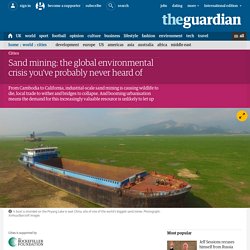
A genial, middle-aged businessman based near Shanghai, China, Fey says he is raking in the equivalent of £180,000 a year from trading in the humblest of commodities: sand. Fey often works in a fishing village on Poyang Lake, China’s biggest freshwater lake and a haven for millions of migratory birds and several endangered species. The village is little more than a tiny collection of ramshackle houses and battered wooden docks. It is dwarfed by a flotilla anchored just offshore, of colossal dredges and barges, hulking metal flatboats with cranes jutting from their decks. Fey comes here regularly to buy boatloads of raw sand dredged from Poyang’s bottom. The demand is voracious. Hundreds of dredgers may be on the lake on any given day, some the size of tipped-over apartment buildings.
All that dredging, researchers believe, is a key reason why the lake’s water level has dropped dramatically in recent years. A building problem Catastrophic damage. Gwynne Dyer - Climate Wars. Live Flight Tracking. Ocean Apocalypse. Goldförderung und ihre Auswirkungen. Goldvorkommen gibt es fast überall auf der Erde.
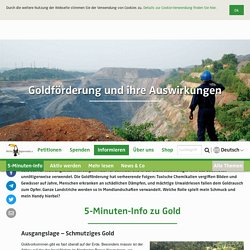
Besonders massiv ist der Abbau auf der der Insel Niolam im Nordosten Papua-Neuguineas, wo täglich ca. 75 Kilo Gold gefördert werden. Im Ländervergleich wird in China das meiste Gold abgebaut: 2016 waren es 455 Tonnen des Edelmetalls, was etwa 13 Prozent der weltweiten Goldproduktion entspricht. Im Jahr 2016 wurde das kostbare Metall zu 47,4 Prozent zu Schmuck verarbeitet; 7,5 Prozent des jährlich geförderten Goldes wurden in der Elektronikindustrie für Handys oder Laptops verwendet.
Den Rest halten Zentralbanken oder Privatanleger als Reserve und zu Spekulationszwecken. Die US-amerikanische Zentralbank besitzt mit 8133,5 Tonnen mit Abstand den größten Goldbestand. Gold kann als körnerartige Goldseifen (Nuggets), die mechanisch vom Bodensubstrat getrennt werden, vorkommen. Daily Overview (@dailyoverview) This video of Earth and the stuff we put on it is mesmerizing. There are many ways to view the wonder of planet Earth: jaw-dropping videos from outer space, scenic “Earth Porn,” gritty “ruin porn” (we love porn).
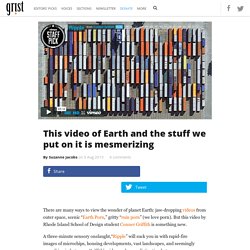
But this video by Rhode Island School of Design student Conner Griffith is something new. A three-minute sensory onslaught,“Ripple” will suck you in with rapid-fire images of microchips, housing developments, vast landscapes, and seemingly everything in between. Griffith’s video makes no distinction between what’s human-made and what’s nature-made, and all the pictures he uses are either extreme closeups or broad overhead views, so sometimes it’s hard to tell what you’re even looking at — is that marble?
Carbon Emissions - an update. Starting today the world gathers in Durban for the COP17 climate change summit.

In times where economic growth is more anticipated than a decline in carbon emissions, the prospects for a successful successor to the Kyoto protocol (coming to an end in 2012) is quite unlikely, and it will be interesting to see, what ‘success’ the delegates have to announce for saving the world from mad and often also tragic consequences of changing climate patterns. The most recent complete views of global carbon emissions are still those released by the United Nations for 2008 which I updated using some additional information to reflect the impact of the global economic crisis in 2008/09 as part of an update to the series of worldmapper cartograms on carbon emissions. Carbon Emissions 2009: (click for larger version)Animation CO2-Emissions 2006-2009: Untitled. 35 facts that will make you never want to eat fish again.
Next time you reach for a spicy tuna handroll, you may want to keep the following infographic in mind.

Eating fish may seem like the safer choice when it comes to environmental impact, but things aren’t as good as they may appear. Shark Finning. The Dizzying Grandeur of 21st-Century Agriculture. Our industrialized food system nourishes more people, at lower cost, than any comparable system in history.
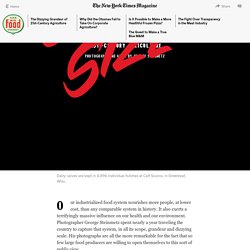
It also exerts a terrifyingly massive influence on our health and our environment. Photographer George Steinmetz spent nearly a year traveling the country to capture that system, in all its scope, grandeur and dizzying scale. His photographs are all the more remarkable for the fact that so few large food producers are willing to open themselves to this sort of public view. Cranberry cultivation began in Massachusetts, and it still brings to mind quaint images of New England. No Soil & Water Before 100% Renewable Energy.
Many say we can have 100% renewable energy by 2050.
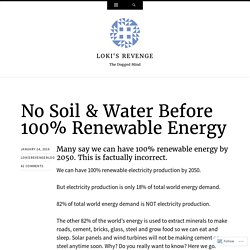
This is factually incorrect. We can have 100% renewable electricity production by 2050. But electricity production is only 18% of total world energy demand. 82% of total world energy demand is NOT electricity production. The other 82% of the world’s energy is used to extract minerals to make roads, cement, bricks, glass, steel and grow food so we can eat and sleep. Europa von schwerster Dürre seit 2100 Jahren betroffen. Nicht nur wegen des Klimawandels: Deutschland drohen Megadürren.